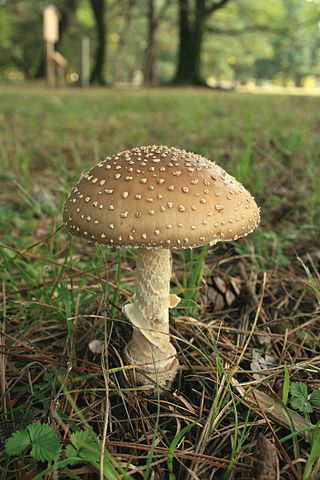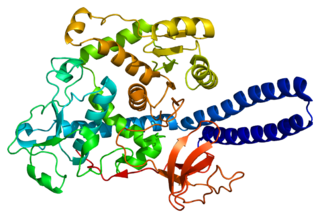Related Research Articles

A nostril is either of the two orifices of the nose. They enable the entry and exit of air and other gasses through the nasal cavities. In birds and mammals, they contain branched bones or cartilages called turbinates, whose function is to warm air on inhalation and remove moisture on exhalation. Fish do not breathe through noses, but they do have two small holes used for smelling, which can also be referred to as nostrils.

Cytokines are a broad and loose category of small proteins important in cell signaling. Cytokines are peptides and cannot cross the lipid bilayer of cells to enter the cytoplasm. Cytokines have been shown to be involved in autocrine, paracrine and endocrine signaling as immunomodulating agents.

Red blood cell distribution width (RDW), as well as various types thereof, is a measure of the range of variation of red blood cell (RBC) volume that is reported as part of a standard complete blood count. Red blood cells have an average volume of 80-100 femtoliters, but individual cell volumes vary even in healthy blood. Certain disorders, however, cause a significantly increased variation in cell size. Higher RDW values indicate greater variation in size. Normal reference range of RDW-CV in human red blood cells is 11.5–15.4%. If anemia is observed, RDW test results are often used together with mean corpuscular volume (MCV) results to determine the possible causes of the anemia. It is mainly used to differentiate an anemia of mixed causes from an anemia of a single cause.
Second messengers are intracellular signaling molecules released by the cell in response to exposure to extracellular signaling molecules—the first messengers. Second messengers trigger physiological changes at cellular level such as proliferation, differentiation, migration, survival, apoptosis and depolarization.

Area codes 541 and 458 are telephone area codes in the North American Numbering Plan (NANP) for most of the U.S. state of Oregon, excluding only the northwestern corner of the state. The service area includes the cities of Eugene, Springfield, Corvallis, Albany, Medford, Bend, Ashland, Klamath Falls, The Dalles, Burns, Lakeview, and Pendleton, as well as the coastal region from Lincoln County to the California border. Area code 541 was created in an area code split from area code 503 on November 5, 1995. Area code 458 was added to the same service area on February 10, 2010 to form an overlay.

Hemosiderin or haemosiderin is an iron-storage complex that is composed of partially digested ferritin and lysosomes. The breakdown of heme gives rise to biliverdin and iron. The body then traps the released iron and stores it as hemosiderin in tissues. Hemosiderin is also generated from the abnormal metabolic pathway of ferritin.

Area codes 503 and 971 are telephone area codes in the North American Numbering Plan (NANP) for the northwestern region of the U.S. state of Oregon. The numbering plan area (NPA) comprises the cities of Portland, Salem, and Astoria. Area code 503 was one of the original North American area codes of 1947, assigned to the entire state until 1995, when its extent was reduced to the northwest corner. Area code 971 was assigned to the service area in stages, completed in 2008, to form an overlay in the area with ten-digit dialing.

The PVC superphylum is a superphylum of bacteria named after its three important members, Planctomycetota, Verrucomicrobiota, and Chlamydiota. Cavalier-Smith postulated that the PVC bacteria probably lost or reduced their peptidoglycan cell wall twice. It has been hypothesised that a member of the PVC clade might have been the host cell in the endosymbiotic event that gave rise to the first proto-eukaryotic cell.

Dikarya is a subkingdom of Fungi that includes the divisions Ascomycota and Basidiomycota, both of which in general produce dikaryons, may be filamentous or unicellular, but are always without flagella. The Dikarya are most of the so-called "higher fungi", but also include many anamorphic species that would have been classified as molds in historical literature. Phylogenetically the two divisions regularly group together. In a 1998 publication, Thomas Cavalier-Smith referred to this group as the Neomycota.

Bartonella bacilliformis is a bacterium, Gram negative aerobic, pleomorphic, flagellated, motile, coccobacillary, 2–3 μm long, 0.2–0.5 μm wide, and a facultative intracellular bacterium.

Transcription factor GATA-6, also known as GATA-binding factor 6 (GATA6), is protein that in humans is encoded by the GATA6 gene. The gene product preferentially binds (A/T/C)GAT(A/T)(A) of the consensus binding sequence.

Oligodendrocyte transcription factor (OLIG2) is a basic helix-loop-helix (bHLH) transcription factor encoded by the Olig2 gene. The protein is of 329 amino acids in length, 32 kDa in size and contains one basic helix-loop-helix DNA-binding domain. It is one of the three members of the bHLH family. The other two members are OLIG1 and OLIG3. The expression of OLIG2 is mostly restricted in central nervous system, where it acts as both an anti-neurigenic and a neurigenic factor at different stages of development. OLIG2 is well known for determining motor neuron and oligodendrocyte differentiation, as well as its role in sustaining replication in early development. It is mainly involved in diseases such as brain tumor and Down syndrome.

Kinesin family member 4A is a protein that in humans is encoded by the KIF4A gene.

Alpha-(1,6)-fucosyltransferase is an enzyme that in humans is encoded by the FUT8 gene.

Krueppel-like factor 9 is a protein that in humans is encoded by the KLF9 gene. Previously known as Basic Transcription Element Binding Protein 1, Klf9 is part of the Sp1 C2H2-type zinc finger family of transcription factors. Several previous studies showed Klf9-related regulation of animal development, including cell differentiation of B cells, keratinocytes, and neurons. Klf9 is also a key transcriptional regulator for uterine endometrial cell proliferation, adhesion, and differentiation, all factors that are essential during the process of pregnancy and are turned off during tumorigenesis.

Carcinoembryonic antigen-related cell adhesion molecule 5 (CEACAM5) also known as CD66e, is a member of the carcinoembryonic antigen (CEA) gene family.

In biology, an organism is any living system that functions as an individual entity. All organisms are composed of cells. The idea of organism is based on the concept of minimal functional unit of life. Three traits have been proposed to play the main role in qualification as an organism:
A matricellular protein is a dynamically expressed non-structural protein that is present in the extracellular matrix (ECM). Rather than serving as stable structural elements in the ECM, these proteins are rapidly turned over and have regulatory roles. They characteristically contain binding sites for ECM structural proteins and cell surface receptors, and may sequester and modulate activities of specific growth factors.

Cyclic guanosine monophosphate–adenosine monophosphate is the first cyclic di-nucleotide found in metazoa. In mammalian cells, cGAMP is synthesized by cyclic GMP-AMP synthase (cGAS) from ATP and GTP upon cytosolic DNA stimulation. cGAMP produced by cGAS contains mixed phosphodiester linkages, with one between 2'-OH of GMP and 5'-phosphate of AMP and the other between 3'-OH of AMP and 5'-phosphate of GMP.
SHC014-CoV is a SARS-like coronavirus (SL-COV) which infects horseshoe bats. It was discovered in Kunming in Yunnan Province, China. It was discovered along with SL-CoV Rs3367, which was the first bat SARS-like coronavirus shown to directly infect a human cell line. The line of Rs3367 that infected human cells was named Bat SARS-like coronavirus WIV1.